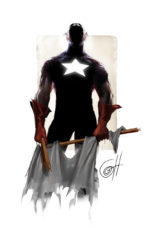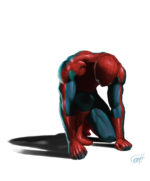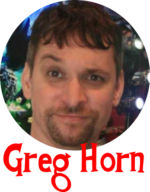 Greg Horn is one of Marvel’s most prolific cover artists. After the Who do you Trust campaign for Marvel’s mega-successful Secret Invasion crossover, Greg disappeared and has not been seen in a year and a half. Now Greg is returning to comics with a new style, and a new publisher as his reinvented look debuts on covers for DC’s mega successful event Blackest Night. He also has a brand new art book, COVER STORIES: The Art of Greg Horn published by Image Comics later this year. Greg stopped by First Comics News to chat with us about his hiatus and return to the world of comics.
Greg Horn is one of Marvel’s most prolific cover artists. After the Who do you Trust campaign for Marvel’s mega-successful Secret Invasion crossover, Greg disappeared and has not been seen in a year and a half. Now Greg is returning to comics with a new style, and a new publisher as his reinvented look debuts on covers for DC’s mega successful event Blackest Night. He also has a brand new art book, COVER STORIES: The Art of Greg Horn published by Image Comics later this year. Greg stopped by First Comics News to chat with us about his hiatus and return to the world of comics.
First Comics News: What have you been doing while you were away from comics?Greg Horn: For the most part, I took care of my family. Early in 2008, my son Andrew was diagnosed with a mental disability, and then later in the year my mother was involved in a very serious automobile accident, and ended up in a rehab institution for almost 4 months. Both of these situations required an immense amount of time from me in them selves, and in Andrewís case, my time off from comics was invaluableóa lot of special classes and personal one-on-one time has really helped him develop properly. In the interim, I lost a lot of my comics steam, but I will always choose family over work!
 1st: You have had a lot of success with a hyper-realistic air brushed look. Why change your art style?
1st: You have had a lot of success with a hyper-realistic air brushed look. Why change your art style?
Greg: Well, I’ve always felt that great artists, whether they be musicians, actors, or comic book artists, always strive to improve on what they have done in the past. Once you work up to your initial artistic style and it is a big hit, you can easily fall into a comfort zone a place where you can become a bit too satisfied with yourself. It’s complacency pure and simple, and a condition that can lead to a big downfall for any artist, because the simple fact of the matter is that people get bored of the same old thing over and over again! In my own way of thinking, I had every reason to keep on doing the same old thing… my airbrush-based style had been immensely successful for me: I managed to rack up 25 advertising campaigns, and almost 50 video game projects under my belt using that style, in addition to 9 straight years of doing nothing but covers at Marvel. But during my time off from comics, I was able to step back from things, and really get a fresh view of the big picture. It was during this period that I decided it was time to change things up, and take a whole new direction with my artwork.
1st: What is the difference between your old style and your new style?
Greg: The biggest difference is the mental approach involved in each style. I know that sounds really artsy-fartsy, but just hear me out. The old technique that I used on books like Elektra and Emma Frost was mainly airbrush in its origins. It involved a lot of masking, a lot of soft edged brushes, and a sadistic attention to detail. My mindset when doing this style, was to try and achieve some kind of perfection. I would paint in a very exacting way, drawing in individual eyelashes, creases in the lips, or stitches in clothing, etc. A very time consuming way of making art to say the least! It was extremely difficult to master because when you try to render things so literally, there is no margin for error–any mistakes or missteps are multiplied and stand out big time!Now, the new reinvention of my art involves going in a completely different direction technique-wise, but also mentally. The new style is almost strictly hand-stroke painted. I avoid cutting any masks at all, and do my best to stay away from those soft edged brushes or anything that is going to create a super-smooth gradient. The mental approach is also completely different: I need to have a don’t worry bout it attitude, and what I mean by that is if I do something in the painting that I perceive is a mistake, I need to either work with it, or paint right over it. I can’t waste energy trying to get something just right, or I am falling back into old habits.
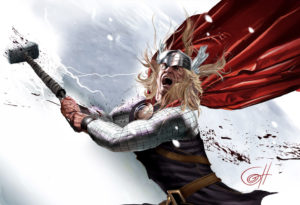 This was a very difficult reinvention for me, because I have been an airbrush guy all my life, and I am simply hardwired for realism and detail. Now I am trying a less is more approach, and sometimes I find myself fighting against old habits to add more detail or go for a more exact representation of whatever I’m painting. At the same time, I don’t want to go too loose, because that is what everybody is doing these days and I am hoping to retain some of the uniqueness that made me such a success in the first place! It is really tough, but the results are so worth all the effort.Another big difference is speed. Most of the paintings I have done since the reinvention, were completed almost twice as fast! It’s really refreshing to just get in there and work, and not worry so much about the consequences.
This was a very difficult reinvention for me, because I have been an airbrush guy all my life, and I am simply hardwired for realism and detail. Now I am trying a less is more approach, and sometimes I find myself fighting against old habits to add more detail or go for a more exact representation of whatever I’m painting. At the same time, I don’t want to go too loose, because that is what everybody is doing these days and I am hoping to retain some of the uniqueness that made me such a success in the first place! It is really tough, but the results are so worth all the effort.Another big difference is speed. Most of the paintings I have done since the reinvention, were completed almost twice as fast! It’s really refreshing to just get in there and work, and not worry so much about the consequences.
1st: Is this still done on the computer?
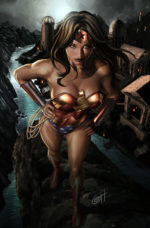 Greg: The base of the Wonder Woman cover was done on paper (yes, actual- real- paper!) in color, then scanned to the computer for some lovely finishing touches. But, this reinvention of mine is like a mad scientist’s experiment, a lot of mixed media and what not. This is actually something I’d been trying to develop since my last cover assignment at Marvel which was the Ms. Marvel annual #1. That cover was also painted on paper and finished up digitally!
Greg: The base of the Wonder Woman cover was done on paper (yes, actual- real- paper!) in color, then scanned to the computer for some lovely finishing touches. But, this reinvention of mine is like a mad scientist’s experiment, a lot of mixed media and what not. This is actually something I’d been trying to develop since my last cover assignment at Marvel which was the Ms. Marvel annual #1. That cover was also painted on paper and finished up digitally!
1st: What do you do if you make a serious error?
Greg: Believe it or not, with the new direction I am taking, an error is the best thing that can happen! An error can send me off in a whole new direction and create something unexpected! Unexpected is good! In fact, I could PURPOSELY make an error-YEAH! I could run a belt-sander right across this Wonder Woman cover, stab it a few times with a butcher knife and it would probably look even better! Hmmm.
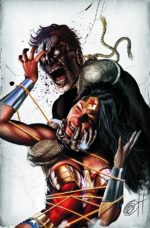 1st: Having spent most of your career at Marvel, how did you end up at DC?
1st: Having spent most of your career at Marvel, how did you end up at DC?
Greg: When I first developed the new stuff, I wasn’t planning to show it to DC; I had never worked there before, and wasn’t sure if they were even interested in me. So, I have to give a lot of credit to Allison Sohn, who saw the Thor painting at my table in San Diego, and convinced me that I should bring it over to the DC booth. She thought it would definitely be something that they would be interested in, and she was right! Anyway, I took a few trips over there during the show and managed to catch up with Dan Didio. He looked at the reinvented art samples and said “I have a job that you’d be perfect for!” and the next thing you know, I’m a cover artist at DC Comics! So far it has been a very exciting time as I get to try out my newest ideas on DC’s characters. I’m itching to paint quite a few of their classic heroes and hopefully Green Lantern and Wonder Woman are just the beginning!
1st: Speaking of San Diego, has the Comic Con provided you with other job opportunities?
Greg: Oh yeah. The San Diego Comic con has been an incredible resource for me for almost 15 years now. If you asked me to list the 10 most important things that have happened in my comic book career, I’d say 8 out of 10 of them happened at, or were negotiated at SDCC. They really should make me their next honorary guest of honor for such a tremendous comment.
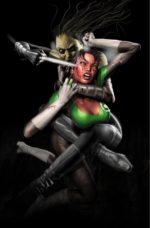 1st: You go to other conventions through the year. Is San Diego unique, or can you find opportunities at other conventions?
1st: You go to other conventions through the year. Is San Diego unique, or can you find opportunities at other conventions?
Greg: There are tons of opportunities to find at any convention, and I have been telling people recently to make sure they stay for Sunday, because with the current economy Sunday tends to be a lot better than it had been in the past! San Diego is unique, and you can pretty much guarantee that everyone you want to see will show up there. It’s great for movie contacts: I am actually working on two film projects right now, and both of these contacts were made at SD.
1st: Now that you are doing covers for DC, do you also have anything coming up at Marvel?
Greg: I haven’t done any covers for Marvel in about a year and a half, but I just got a call from them last week to do a 6-page interior project (Dark Avengers #11). With the new technique, I am getting these pages done much quicker than usual.
 1st: In addition to DC and Marvel, you also have COVER STORIES: The Art of Greg Horn Vol. 2 coming out from Image.Will the Art Book include Marvel and DC covers?
1st: In addition to DC and Marvel, you also have COVER STORIES: The Art of Greg Horn Vol. 2 coming out from Image.Will the Art Book include Marvel and DC covers?
Greg: There was a legal process for obtaining permission to use any of the licensed artwork in my art book. So, I guess I am saying “Yes.” Anyway, the hardcover version published by Image Comics was solicitated in last month’s PREVIEWS catalog (for books on sale in November). So, I’m a little late here, but I believe the book can still be ordered through your local comic book retailer.
1st: Your previous art book was a big seller if I remember. Have you made many changes in the new art book?
Greg: Yes, The first edition hardcovers were a complete sellout in about a week, and this new book is much better quality– not to mention that the cover is probably the most outstanding conceptual artistic masterpiece of all time; I’m serious. Anyway, COVER STORIES: The Art of Greg Horn has all new material, and essentially picks up where Volume #1 left off in 2004, so it is a great companion piece for anyone who loves art!
1st: You did work for Ringling Bros. Barnum and Bailey Circus as well as the Olympics Poster. Is there a section on advertising art?
Greg: Most of my artwork on advertising campaigns will be printed in the new art book. Included are illustrations from the bumper ads I did for Spike TVs 2009 Scream Awards, package art forHasbro’s G.I. Joe action figures, and the redesign of the classic board game Stratego. There are also some really cool video game Print ads for NBA Live, City of the Dead, and Splinter Cell among others.
1st: How do you choose art for the book?
Greg: I try to choose the best possible pieces to include in the art book. After all it is a promotion of me as an artist, and I would not want it reflecting poorly. I’ve seen way too many books that have one great painting for every three or four bad ones, or the whole back end of the book is just terrible filler. That’s always a disappointment, and I think those artists should be shunned and burned alive in that order. Anyway, I’ve broken the book up into many categories to accommodate the variety of work I’ve done in different industries recently. The categories are Mainstream Comics, Indy comics, fantasy art, Concept Art and Character Design, Advertising, Sports Illustration, and Video Game Art. The categories help create the illusion of organization in my book. There is also a feature at the end discussing the new art and how I went about developing it.
1st: Do you provide pointers for aspiring artists?
Greg: Well, my pointers are more inspirational than instructional. I tell aspiring artists to never give up on their dream, and when bad things happen to them (which they always do), they must realize that they may be turned in a new better direction, and what they thought was a horrible situation will eventually turn to something good. I tell the story of when I first decided I wanted to be a comic book artist; all I ever wanted was to be a great penciler, just like my heroes Perez, Bryne, and Buscema. But I could never make my big break into mainstream comics with pencils, and for 11 years I cursed my luck. But then, looking back I realize if I had been hired by a big company back then like I wanted, I may have never taken the path of painting, and subsequently publishing my creator-owned painted book which eventually caught the eye of Marvel comics and led them to hire me as a high-falootin’ cover artist.

